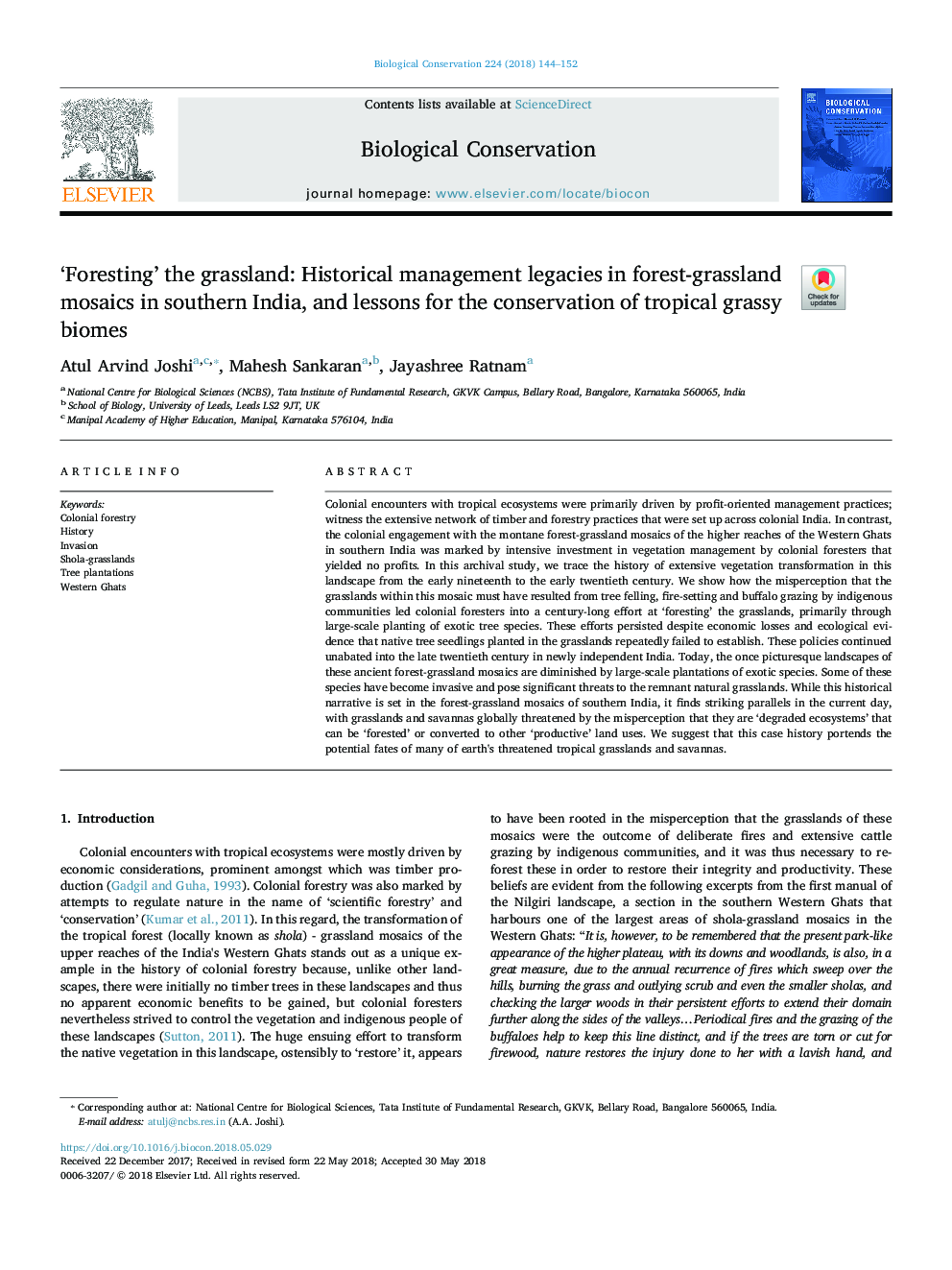| کد مقاله | کد نشریه | سال انتشار | مقاله انگلیسی | نسخه تمام متن |
|---|---|---|---|---|
| 8847190 | 1617881 | 2018 | 9 صفحه PDF | دانلود رایگان |
عنوان انگلیسی مقاله ISI
'Foresting' the grassland: Historical management legacies in forest-grassland mosaics in southern India, and lessons for the conservation of tropical grassy biomes
ترجمه فارسی عنوان
"جنگلداری" چمنزار: پراکندگی مدیریت تاریخی در موزاییکهای چمنزارهای جنگلی در جنوب هند و درسهای حفاظت از زیستگاههای گیاهی گرمسیری
دانلود مقاله + سفارش ترجمه
دانلود مقاله ISI انگلیسی
رایگان برای ایرانیان
کلمات کلیدی
جنگل مستعمراتی، تاریخ، تهاجم، چمنزارهای شولا، کاشت درختان، غربی غربی،
ترجمه چکیده
درگیری های استعماری با اکوسیستم های گرمسیری عمدتا توسط شیوه های مدیریت سود بر مبنای هدایت می شود؛ شاهد شبکه وسیعی از شیوه های چوب و جنگلداری است که در سراسر هند استعماری ایجاد شده است. در مقابل، مشارکت استعماری با موزاییکهای چمنزارهای مونتن از قفقات غربی در جنوب هند، با سرمایه گذاری شدید در جنگلداری مستعمراتی که در آن هیچ سود حاصل نمی شد، مدیریت سرمایه گذاری را نشان داد. در این مطالعه بایگانی، تاریخ تحولات گسترده گیاهی در این منظره از اوایل نوزدهم تا اوایل قرن بیستم را دنبال می کنیم. ما نشان می دهیم که چگونه این تصور اشتباه که چمنزار درون این موزاییک باید از برداشت درختان، آتش سوزی و گاو شیری بوفالو توسط جوامع بومی برگزار شود، جنگلاران مستعمرات را به تلاش یک قرن طول می کشد تا در کنار گذاشتن چمنزارها، عمدتا از طریق کاشت در مقیاس بزرگ گونه های درخت عجیب و غریب این تلاش ها با وجود زیان های اقتصادی و شواهد زیست محیطی ادامه یافت و نشان داد که نهال های بومی درخت کاشته شده در چمنزارها بارها تأسیس شده اند. این سیاست ها در اواخر قرن بیستم در هند مستقل مستقل ادامه یافت. امروزه مناظر مجسمه ای از این موزاییک های جنگل و باستانی قدیم توسط گیاهان گسترده ای از گونه های عجیب و غریب کاهش می یابد. برخی از این گونه ها تهاجمی بوده و تهدیدات مهمی برای مراتع طبیعی بقایای آنها است. در حالیکه این روایت تاریخی در موزاییکهای چمنزارهای جنگل جنوبی هندوستان قرار دارد، در روز جاری هماهنگی قابل توجهی پیدا می شود؛ با علف های هرز و ساوانا در سطح جهان از تهدید غلط تهدید می شود که آنها "تخریب اکوسیستم" هستند که می توانند "جنگل" یا تبدیل به دیگر "تولید" زمین استفاده می کند. ما پیشنهاد می کنیم که این مورد تاریخچه احتمال سرنوشت بسیاری از علف های هرز گرمسیری و ساوانا را تهدید می کند.
موضوعات مرتبط
علوم زیستی و بیوفناوری
علوم کشاورزی و بیولوژیک
بوم شناسی، تکامل، رفتار و سامانه شناسی
چکیده انگلیسی
Colonial encounters with tropical ecosystems were primarily driven by profit-oriented management practices; witness the extensive network of timber and forestry practices that were set up across colonial India. In contrast, the colonial engagement with the montane forest-grassland mosaics of the higher reaches of the Western Ghats in southern India was marked by intensive investment in vegetation management by colonial foresters that yielded no profits. In this archival study, we trace the history of extensive vegetation transformation in this landscape from the early nineteenth to the early twentieth century. We show how the misperception that the grasslands within this mosaic must have resulted from tree felling, fire-setting and buffalo grazing by indigenous communities led colonial foresters into a century-long effort at 'foresting' the grasslands, primarily through large-scale planting of exotic tree species. These efforts persisted despite economic losses and ecological evidence that native tree seedlings planted in the grasslands repeatedly failed to establish. These policies continued unabated into the late twentieth century in newly independent India. Today, the once picturesque landscapes of these ancient forest-grassland mosaics are diminished by large-scale plantations of exotic species. Some of these species have become invasive and pose significant threats to the remnant natural grasslands. While this historical narrative is set in the forest-grassland mosaics of southern India, it finds striking parallels in the current day, with grasslands and savannas globally threatened by the misperception that they are 'degraded ecosystems' that can be 'forested' or converted to other 'productive' land uses. We suggest that this case history portends the potential fates of many of earth's threatened tropical grasslands and savannas.
ناشر
Database: Elsevier - ScienceDirect (ساینس دایرکت)
Journal: Biological Conservation - Volume 224, August 2018, Pages 144-152
Journal: Biological Conservation - Volume 224, August 2018, Pages 144-152
نویسندگان
Atul Arvind Joshi, Mahesh Sankaran, Jayashree Ratnam,
